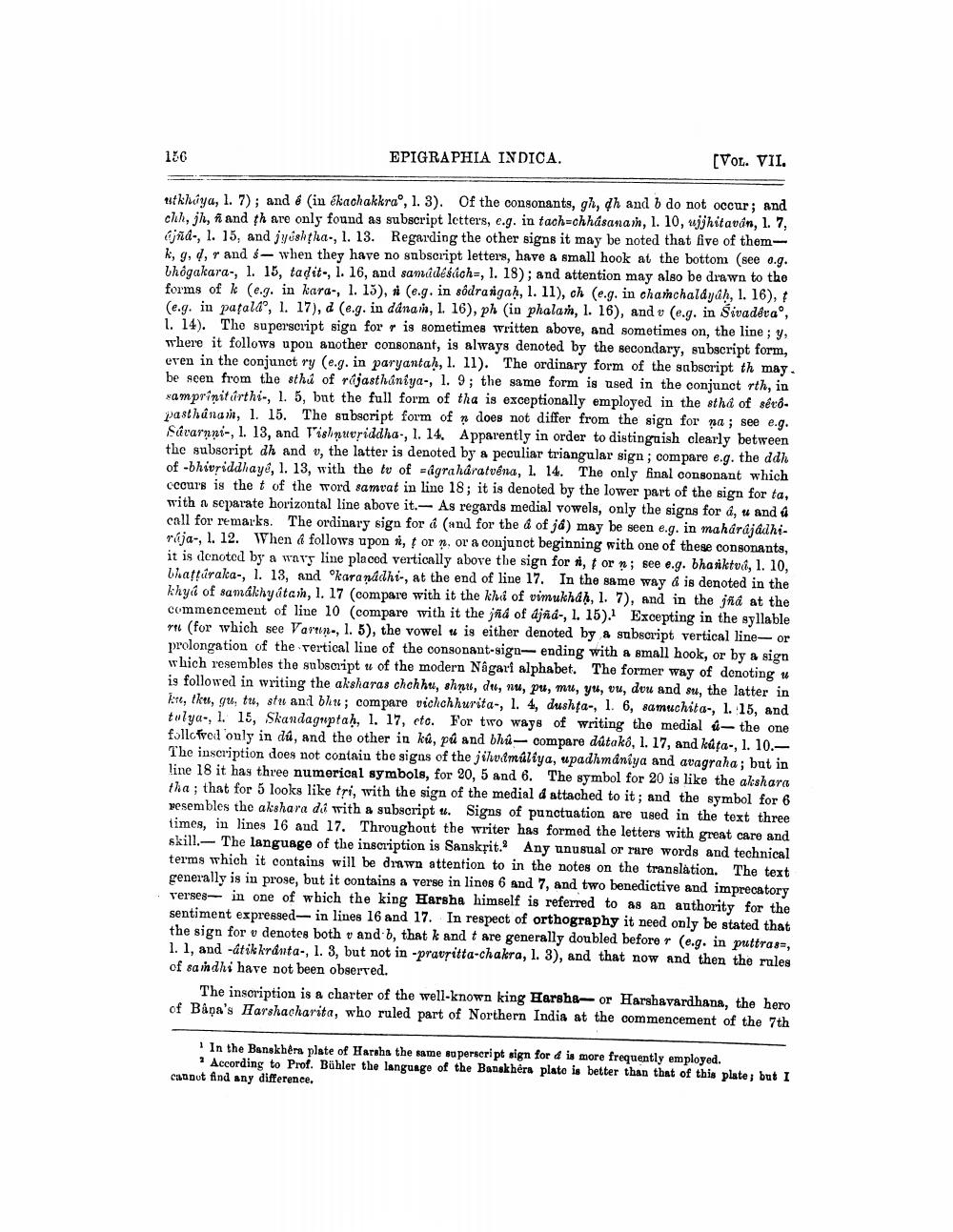________________
136
EPIGRAPHIA INDICA.
[VOL. VII.
utkhiya, 1. 7); and & (in ékachakkra°, 1. 3). Of the consonants, gh, dh and b do not occur; and chh, jh, fi and th are only found as subscript letters, e.g. in tach=chhasanam, 1. 10, ujjhitavan, 1. 7, and., 1. 15, and jyishtha., 1. 13. Regarding the other signs it may be noted that five of themk, g, d, r and s- when they have no subscript letters, have a small hook at the bottom (see o.g. Thôgakaras, 1. 15, tadit., l. 16, and sanidésich=, 1. 18); and attention may also be drawn to the forms of k (e.g. in kara-, l. 15), (e.g. in sôdranigah, 1. 11), ch (e.g. in chanchaldyah, 1. 16), (e.g. in parald', 1. 17), d (e.g. in dánaria, 1. 16), ph (in phalan, 1. 16), and v (e.g. in Sivadêrao, 1. 14). The superscript sign for r is sometimes written above, and sometimes on, the line ; y, where it follows upon another consonant, is always denoted by the secondary, subscript form, even in the conjunct ry (e.g. in paryantah, 1. ll). The ordinary form of the subscript th may. be seen from the sthú of rajasthaniya-, 1. 9; the same form is used in the conjunct rth, in samprinitärthi-, l. 5, but the full form of tha is exceptionally employed in the stha of sêrô. pasthanait, l. 15. The subscript form of n does not differ from the sign for na; see e.g. Sárarnni-, 1. 13, and t'islmuesiddha., 1. 14. Apparently in order to distinguish clearly between the subscript dh and v, the latter is denoted by a peculiar triangular sign; compare e.g. the ddh of -bhivriddhayd, 1. 13, with the tu of Fagraharatvena, l. 14. The only final consonant which occurs is the t of the word samcat in line 18; it is denoted by the lower part of the sign for ta, with a separate horizontal line above it.- As regards medial vowels, only the signs for d, u and a call for remarks. The ordinary sign for a (and for the & of já) may be seen e.g. in maharajadhi. rája-, 1. 12. When a follows upons, or n, or a conjunct beginning with one of these consonants, it is denoted by a wavy line placed vertically above the sign for stor n; see e.g. bhariktui, 1. 10, battúraka-, l. 13, and kara nádhi-, at the end of line 17. In the same way & is denoted in the khy of samakhyátain, 1. 17 compare with it the khi of vimukha), 1. 7), and in the jña at the commencement of line 10 (compare with it the jñid of djña-, 1. 15). Excepting in the syllable r. (for which see Vartin., 1. 5), the vowel is either denoted by a subscript vertical line- or prolongation of the vertical line of the consonant-sign- ending with a small hook, or by a sign which resembles the subscript u of the modern Nagari alphabet. The former way of denoting is followed in writing the aksharas chchhu, shnu, dos, nu, pu, mu, yu, vu, deu and su, the latter in kort, tkes, gu, tt, stui and bhtt; compare vichchhurita-, 1. 4, dushta-, 1. 6, samuchitas, 1. 15, and tulya-, l. 15, Skandaguptah, 1. 17, cto. For two ways of writing the medial ů- the one follcfood only in da, and the other in ků, pů and bhi-compare datako, 1. 17, and kata-, 1. 10.The inscription does not contain the signs of the jihuilmúliya, upadhmaniya and avagraha; but in line 18 it has three numerical symbols, for 20, 5 and 6. The symbol for 20 is like the akshara tha; that for 5 looks like tri, with the sign of the medial d attached to it; and the symbol for 6 resembles the akshara då with a subscript 1. Signs of punctuation are used in the text three times, in lines 16 and 17. Throughout the writer has formed the letters with great care and skill. The language of the inscription is Sanskrit. Any unusual or rare words and technical terms which it contains will be down attention to in the notes on the translation. The text generally is in prose, but it contains a verse in lines 6 and 7, and two benedictive and imprecatory verses- in one of which the king Harsha himself is referred to as an authority for the sentiment expressed in lines 16 and 17. In respect of orthography it need only be stated that the sign for v denotes both v and b, that k and t are generally doubled before r (e.g. in puttras, 1. 1, and -&tikkrånta, 1. 3, but not in -pravritta-chakra, 1. 3), and that now and then the rules of sandhi have not been observed.
The inscription is a charter of the well-known king Harsha-or Harshavardhana, the hero of Bapa's Harshacharita, who ruled part of Northern India at the commencement of the 7th
In the Banskhera plate of Harsha the same superscript sign for d is more frequently employed.
? According to Prof. Bühler the language of the Banskhera plato is better than that of this plate; but I eadnut find any difference.




